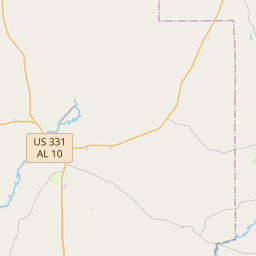Allred House & Cemetery
Historical marker location:
Goshen, Alabama
( Marker is on County Road 2290, ¾ mile north of Little Oak Road (County Road 2238), on the right when traveling north.)
Marker installed: 2012







© OpenStreetMap contributors
Alabama is home to the oldest baseball stadium in the United States. Rickwood Field, located in Birmingham, was built in 1910 and is still in use today.
About Pike County
Pike County Timeline
Pike County, Alabama has a rich history dating back thousands of years. The area was originally inhabited by Native American tribes such as the Creek and Cherokee, who lived off the land and established their own communities. In the late 18th century, European settlers began to arrive, primarily from Georgia and the Carolinas, attracted by the fertile land and abundant natural resources.
The county was officially established on December 17, 1821, and was named after Zebulon Pike, a renowned explorer from the early 19th century. It quickly became an agricultural hub, with cotton plantations dominating the economy. Slavery was prevalent in Pike County, as it was in much of the South during this era. After the Civil War, many freed slaves settled in the county, contributing to its diverse cultural heritage.
During the late 19th and early 20th centuries, Pike County experienced significant economic growth and industrial development. The arrival of the railroad in the 1880s spurred commerce and facilitated the export of agricultural goods. Timber and lumber production also played a vital role in the county's economy.
In recent decades, Pike County has seen a shift towards a more diversified economy, with the establishment of light manufacturing and service industries. Troy University, founded in 1887, has become an integral part of the community, bringing educational and cultural opportunities to the area. Today, Pike County continues to be a vibrant and thriving county, preserving its unique history while embracing the challenges and opportunities of the modern world.
The county was officially established on December 17, 1821, and was named after Zebulon Pike, a renowned explorer from the early 19th century. It quickly became an agricultural hub, with cotton plantations dominating the economy. Slavery was prevalent in Pike County, as it was in much of the South during this era. After the Civil War, many freed slaves settled in the county, contributing to its diverse cultural heritage.
During the late 19th and early 20th centuries, Pike County experienced significant economic growth and industrial development. The arrival of the railroad in the 1880s spurred commerce and facilitated the export of agricultural goods. Timber and lumber production also played a vital role in the county's economy.
In recent decades, Pike County has seen a shift towards a more diversified economy, with the establishment of light manufacturing and service industries. Troy University, founded in 1887, has become an integral part of the community, bringing educational and cultural opportunities to the area. Today, Pike County continues to be a vibrant and thriving county, preserving its unique history while embracing the challenges and opportunities of the modern world.
Pike County Timeline
This timeline provides a condensed summary of the historical journey of Pike County, Alabama.
- 1819: Pike County is established on December 17
- 1826: Troy is incorporated as the county seat
- 1830s: Pike County experiences a boom in cotton production
- 1861-1865: Pike County residents participate in the American Civil War
- 1881: The Alabama Midland Railway is completed, connecting Troy to Montgomery
- 1930s: Pike County suffers from the Great Depression
- 1967: The U.S. Army's Aviation Applied Technology Directorate is established in Pike County
- 1976: The Pioneer Museum of Alabama is opened in Troy
- 1990s: Pike County experiences significant growth in manufacturing and healthcare industries